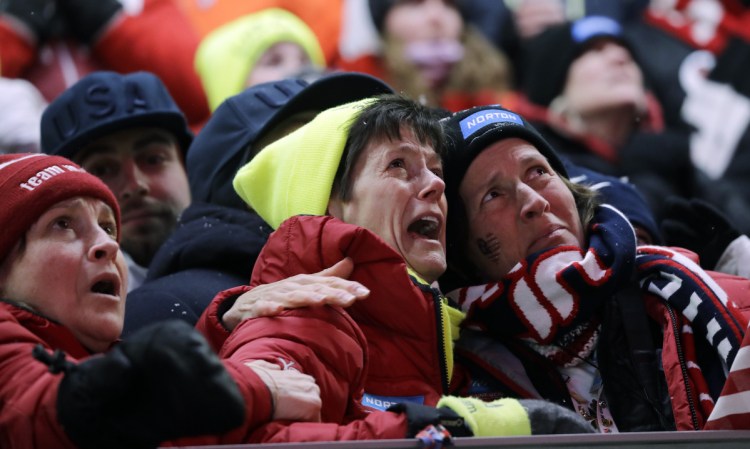Emily Sweeney’s Olympic debut ended with a frightening crash.
The 24-year-old Maine native started to lose control on Curve 9 of her fourth and final run of women’s singles luge Tuesday. She skidded sideways and careened down the steep and icy track before hitting her head and then her feet on opposite walls at the Olympic Sliding Centre in PyeongChang, South Korea. She was thrown from her sled and eventually tumbled to a stop.
Medical personnel clambered onto the track to attend to Sweeney as a hush fell over the crowd. Television cameras on NBC’s live feed avoided showing her after the crash. A stretcher was brought out, but after several tense minutes Sweeney was able to get to her feet. Several more minutes passed before she gingerly walked to the finish area amid relieved applause.
The diagnosis was that Sweeney had no broken bones, only some bumps and bruises.
“I’ve never been so relieved than when I saw her getting up and walking,” American teammate Summer Britcher told The Associated Press, choking back tears.
Many in the crowd, including Sweeney’s mother, Sue Sweeney, stared in horror at monitors showing the crash. Raucous fans who filled the stands and had been cheering wildly before the accident, immediately went silent as they waited for some sign that Sweeney would be all right.
Sweeney spoke with NBC’s Lewis Johnson before heading to the hospital for evaluation.
“There’s a lot of pressures in these big curves and unfortunately, I was not taking them correctly,” said Sweeney, whose speed on the sled approached 80 mph and protective equipment included little more than gloves, a slick suit and a visored helmet. “So it was pretty rough.”

Emily Sweeney of the United States prepares for the start of her second run Tuesday.
Curve 9 has been a problem for sliders throughout the early portion of the Olympics, causing many to skid, lose control and lose time. Crashes, however, have not come as often as they did in the 2006 and 2010 Winter Games, both of which left athletes openly complaining about track safety.
Later in the final runs Tuesday, Britcher lost control at the start and collided with some walls – but got down the track without crashing or serious injury.
“I’m very sore, and pretty stiff,” Sweeney told Johnson. “I’m going to get an X-ray on my back after this, but I wanted to have the last word. So thanks for all the support, you guys. It’s a bummer, for sure, and I know that I’m better than that. But here we are – it happens.”
Sweeney was born in Portland and attended school in Falmouth before her family moved to Suffield, Connecticut. Her maternal grandparents ran O’Donal’s Nursery in Gorham for decades and still live in the area.
Monday marked the eighth anniversary of the death of Georgian luger Nodar Kumaritashvili in Whistler, British Columbia, on the eve of the 2010 Vancouver Winter Olympics.
Sweeney, whose older sister Megan competed in those 2010 games, entered the final run in 14th place, having moved up one spot following her first two runs. She entered the competition ranked 11th in the world.
Thirteen sliders followed Sweeney, after a significant delay, and Germany’s Natalie Geisenberger won the gold medal, as she did in Sochi four years ago. Teammate Dajana Eitberger earned silver, 0.367 seconds behind Geisenberger’s four-run combined time of 3 minutes, 5.232 seconds.
Alex Gough won Canada’s first medal in luge, taking bronze. She was 0.412 seconds behind Geisenberger.
The other two U.S. lugers, Erin Hamlin and Britcher, placed sixth and 19th, respectively. Hamlin was a bronze medalist in 2014.
Only 20 women from the original field of 30 advanced to the final two runs. Sweeney’s official result was DNF, for Did Not Finish.
Glenn Jordan can be contacted at 791-6425 or
Gjordan@pressherald.com
Twitter: GlennJordanPPH
Send questions/comments to the editors.



Comments are no longer available on this story